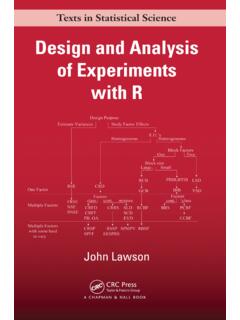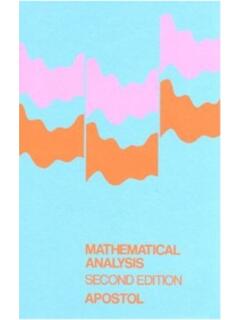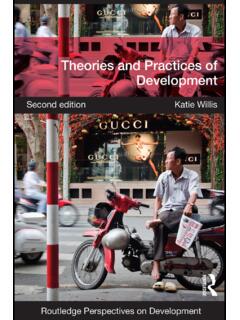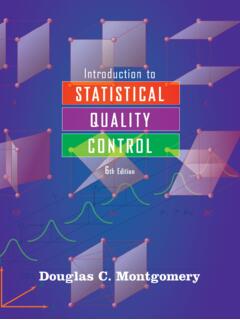Transcription of Design and Analysis of Experiments - University of Rajshahi
1 Design and Analysis of ExperimentsEighth EditionDOUGLAS C. MONTGOMERYA rizona State UniversityJohn Wiley & Sons, PRESIDENT AND PUBLISHERD onald FowleyACQUISITIONS EDITORL inda RattsCONTENT MANAGERL ucille BuonocorePRODUCTION EDITORAnna MelhornMARKETING MANAGERC hristopher RuelDESIGN DIRECTORH arry NolanSENIOR DESIGNERM aureen EideEDITORIAL ASSISTANTC hristopher TejaPRODUCTION SERVICES Namit Grover/Thomson DigitalCOVER PHOTONik Wheeler/Corbis ImagesCOVER DESIGNW endy LaiThis book was set in Times by Thomson Digital and printed and bound by Courier Westford. The cover was printed by Courier book is printed on acid-free paper. Founded in 1807, John Wiley & Sons, Inc. has been a valued source of knowledge and understanding for morethan 200 years, helping people around the world meet their needs and fulfill their aspirations. Our company is builton a foundation of principles that include responsibility to the communities we serve and where we live and 2008, we launched a Corporate Citizenship Initiative, a global effort to address the environmental, social,economic, and ethical challenges we face in our business.
2 Among the issues we are addressing are carbon impact,paper specifications and procurement, ethical conduct within our business and among our vendors, and communityand charitable support. For more information, please visit our website: 2013, 2009, 2005, 2001, 1997 John Wiley & Sons, Inc. All rights reserved. No part of this publicationmay be reproduced, stored in a retrieval system or transmitted in any form or by any means, electronic, mechanical,photocopying, recording, scanning or otherwise, except as permitted under Sections 107 or 108 of the 1976 United States Copyright Act, without either the prior written permission of the Publisher, or authorization throughpayment of the appropriate per-copy fee to the Copyright Clearance Center, Inc., 222 Rosewood Drive, Danvers,MA 01923, website Requests to the Publisher for permission should be addressed to thePermissions Department, John Wiley & Sons, Inc., 111 River Street, Hoboken, NJ 07030-5774, (201) 748-6011,fax (201) 748-6008, website copies are provided to qualified academics and professionals for review purposes only, for use in theircourses during the next academic year.
3 These copies are licensed and may not be sold or transferred to a thirdparty. Upon completion of the review period, please return the evaluation copy to Wiley. Return instructions and afree of charge return shipping label are available at Outside of the United States,please contact your local order books or for customer service, please call 1-800-CALL WILEY (225-5945).Library of Congress Cataloging-in-Publication Data:Montgomery, douglas and Analysis of Experiments / douglas C. Montgomery. Eighth cmIncludes bibliographical references and 978-1-118-14692-71. Experimental Design . I. Title. '7 dc232012000877 ISBN 978-1118-14692-710 9 8 7 6 5 4 3 2 1 PrefaceAudienceThis is an introductory textbook dealing with the Design and Analysis of Experiments . It is basedon college-level courses in Design of Experiments that I have taught over nearly 40 years atArizona State University , the University of Washington, and the Georgia Institute of also reflects the methods that I have found useful in my own professional practice as an engi-neering and statistical consultant in many areas of science and engineering, including the researchand development activities required for successful technology commercialization and book is intended for students who have completed a first course in statistical meth-ods.
4 This background course should include at least some techniques of descriptive statistics,the standard sampling distributions, and an introduction to basic concepts of confidenceintervals and hypothesis testing for means and variances. Chapters 10, 11, and 12 requiresome familiarity with matrix the prerequisites are relatively modest, this book can be used in a second courseon statistics focusing on statistical Design of Experiments for undergraduate students in engi-neering, the physical and chemical sciences, statistics, mathematics, and other fields of many years I have taught a course from the book at the first-year graduate level in engi-neering. Students in this course come from all of the fields of engineering, materials science,physics, chemistry, mathematics, operations research life sciences, and statistics. I have alsoused this book as the basis of an industrial short course on Design of Experiments for practic-ing technical professionals with a wide variety of backgrounds.
5 There are numerous examplesillustrating all of the Design and Analysis techniques. These examples are based on real-worldapplications of experimental Design and are drawn from many different fields of engineering andthe sciences. This adds a strong applications flavor to an academic course for engineersand scientists and makes the book useful as a reference tool for experimenters in a varietyof the BookThe eighth edition is a major revision of the book. I have tried to maintain the balancebetween Design and Analysis topics of previous editions; however, there are many new topicsand examples, and I have reorganized much of the material. There is much more emphasis onthe computer in this , JMP, and Minitab SoftwareDuring the last few years a number of excellent software products to assist experimenters inboth the Design and Analysis phases of this subject have appeared. I have included output fromthree of these products, Design -Expert, JMP, and Minitab at many points in the text.
6 Minitaband JMP are widely available general-purpose statistical software packages that have gooddata Analysis capabilities and that handles the Analysis of Experiments with both fixed and ran-dom factors (including the mixed model). Design -Expert is a package focused exclusively onexperimental Design . All three of these packages have many capabilities for construction andevaluation of designs and extensive Analysis features. Student versions of Design -Expert andJMP are available as a packaging option with this book, and their use is highly recommend-ed. I urge all instructors who use this book to incorporate computer software into yourcourse. (In my course, I bring a laptop computer and use a computer projector in everylecture, and every Design or Analysis topic discussed in class is illustrated with the computer.)To request this book with the student version of JMP or Design -Expert included, contactyour local Wiley representative.
7 You can find your local Wiley representative by going and clicking on the tab for Who s My Rep? Empirical ModelI have continued to focus on the connection between the experiment and the model thatthe experimenter can develop from the results of the experiment . Engineers (and physical,chemical and life scientists to a large extent) learn about physical mechanisms and theirunderlying mechanistic models early in their academic training, and throughout much oftheir professional careers they are involved with manipulation of these designed Experiments offer the engineer a valid basis for developing anempiricalmodel of the system being investigated. This empirical model can then bemanipulated (perhaps through a response surface or contour plot, or perhaps mathemati-cally) just as any other engineering model. I have discovered through many years of teachingthat this viewpoint is very effective in creating enthusiasm in the engineering communityfor statistically designed Experiments .
8 Therefore, the notion of an underlying empiricalmodel for the experiment and response surfaces appears early in the book and receivesmuch more DesignsI have expanded the material on factorial and fractional factorial designs (Chapters 5 9) inan effort to make the material flow more effectively from both the reader s and the instruc-tor s viewpoint and to place more emphasis on the empirical model. There is new materialon a number of important topics, including follow-up experimentation following a fractionalfactorial, nonregular and nonorthogonal designs, and small, efficient resolution IV and Vdesigns. Nonregular fractions as alternatives to traditional minimum aberration fractions in16 runs and Analysis methods for these Design are discussed and Important ChangesI have added a lot of material on optimal designs and their application. The chapter on responsesurfaces (Chapter 11) has several new topics and problems.
9 I have expanded Chapter 12 onrobust parameter Design and process robustness Experiments . Chapters 13 and 14 discussexperiments involving random effects and some applications of these concepts to nested andsplit-plot designs. The residual maximum likelihood method is now widely available in soft-ware and I have emphasized this technique throughout the book. Because there is expandingindustrial interest in nested and split-plot designs, Chapters 13 and 14 have several new 15 is an overview of important Design and Analysis topics: nonnormality of theresponse, the Box Cox method for selecting the form of a transformation, and other alterna-tives; unbalanced factorial Experiments ; the Analysis of covariance, including covariates in afactorial Design , and repeated measures. I have also added new examples and problems fromvarious fields, including biochemistry and DesignThroughout the book I have stressed the importance of experimental Design as a tool for engi-neers and scientists to use for product Design and development as well as process develop-ment and improvement.
10 The use of experimental Design in developing products that are robustto environmental factors and other sources of variability is illustrated. I believe that the use ofexperimental Design early in the product cycle can substantially reduce development lead timeand cost, leading to processes and products that perform better in the field and have higherreliability than those developed using other book contains more material than can be covered comfortably in one course, and Ihope that instructors will be able to either vary the content of each course offering or discusssome topics in greater depth, depending on class interest. There are problem sets at the endof each chapter. These problems vary in scope from computational exercises, designed toreinforce the fundamentals, to extensions or elaboration of basic SuggestionsMy own course focuses extensively on factorial and fractional factorial designs. Consequently,I usually cover Chapter 1, Chapter 2 (very quickly), most of Chapter 3, Chapter 4 (excludingthe material on incomplete blocks and only mentioning Latin squares briefly), and I discussChapters 5 through 8 on factorials and two-level factorial and fractional factorial designs indetail.














